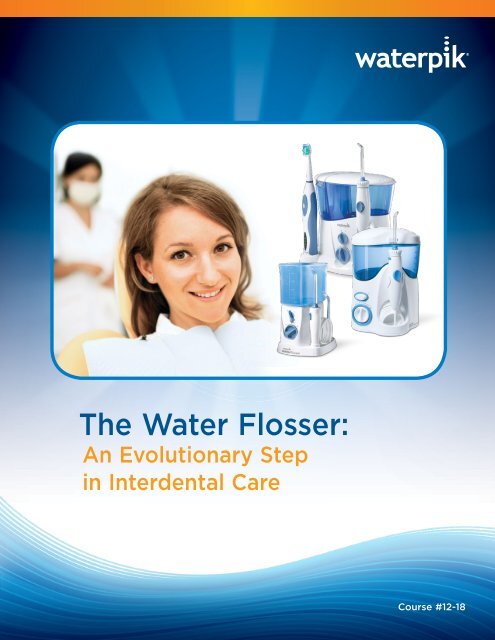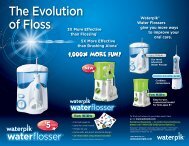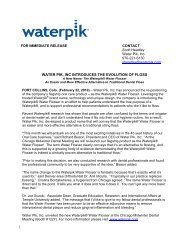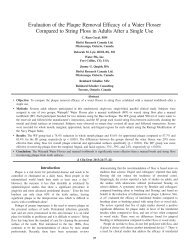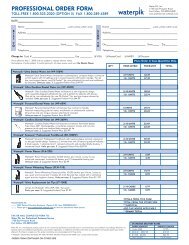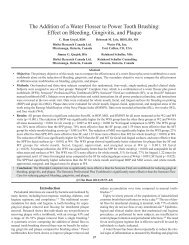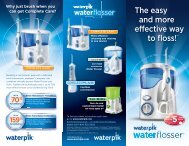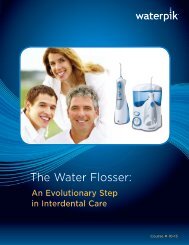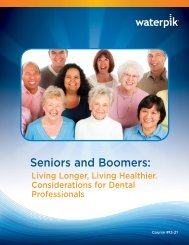The Water Flosser: An Evolutionary Step in Interdental Care - Waterpik
The Water Flosser: An Evolutionary Step in Interdental Care - Waterpik
The Water Flosser: An Evolutionary Step in Interdental Care - Waterpik
You also want an ePaper? Increase the reach of your titles
YUMPU automatically turns print PDFs into web optimized ePapers that Google loves.
• <strong>The</strong> Orthodontic Tip can also be used around orthodonticbrackets.• With the Toothbrush Tip, brush<strong>in</strong>g action should also beemployed. Toothpaste may be used.<strong>The</strong> Pik Pocket tip has been designed for low-pressure delivery.It is latex-free. S<strong>in</strong>ce this tip is site specific, <strong>in</strong>dividuals will need toknow exactly where <strong>in</strong> the mouth it should be used.To use the Pik Pocket Tip:• Turn the unit to the lowest pressure sett<strong>in</strong>g. Failure to do thismay shorten the life of the unit (Figure 25).• Gently place the tip just slightly below the g<strong>in</strong>gival marg<strong>in</strong>(Figure 26).• Use a mirror to check that the tip is <strong>in</strong> the correct place.• Briefly hold the tip <strong>in</strong> place before proceed<strong>in</strong>g to another area.To use the Tongue Cleaner:• Turn the unit to the lowest pressure sett<strong>in</strong>g.• Place the Tongue Cleaner <strong>in</strong> the center/midl<strong>in</strong>e of the tongueabout halfway back.• Gently pull the Tongue Cleaner forward.• Repeat several times.Current Models<strong>The</strong>re are two basic types of models, a countertop version andcordless version. Both have a pulsation rate and pressure rangeconsistent with what is needed to achieve cl<strong>in</strong>ical outcomes. <strong>The</strong>ywill accommodate most types of antimicrobial agents.<strong>The</strong> <strong>Water</strong>pik ® Ultra <strong>Water</strong> <strong>Flosser</strong> is a countertop model (Figure27). It is the number one choice with dental professionals. This unitis smaller and quieter than previous countertop models. It has tenpressure sett<strong>in</strong>gs for optimal control. <strong>The</strong> high volume reservoirprovides a water capacity for 90 seconds of clean<strong>in</strong>g, enough tocleanse the entire mouth.<strong>The</strong> <strong>Water</strong>pik ® Complete <strong>Care</strong> bundles the proven technology ofthe <strong>Water</strong> <strong>Flosser</strong> with a sonic toothbrush. Like the Ultra, there are10 pressure sett<strong>in</strong>gs along with high volume reservoir that providesfor 90 seconds of clean<strong>in</strong>g. This product comes with five tips. Twotoothbrush heads are also <strong>in</strong>cluded (Figure 19).<strong>The</strong> <strong>Water</strong>pik ® Traveler is about 50% smaller than the Ultra modelis and comes with global voltage, perfect for the world traveler oranyone with limited counter space. It has three pressure sett<strong>in</strong>gsand comes with four tips (Figure 28).For children ages 6–12, the <strong>Water</strong>pik ® <strong>Water</strong> <strong>Flosser</strong> For Kidscomes with a handle designed for smaller hands. <strong>The</strong>re are threepressure sett<strong>in</strong>gs, and it comes with two tips. To make <strong>Water</strong>Floss<strong>in</strong>g fun, the unit comes with 20 decals (Figure 29).SummaryS<strong>in</strong>ce its <strong>in</strong>troduction <strong>in</strong> 1962, the <strong>Water</strong>pik ® <strong>Water</strong> <strong>Flosser</strong> hasbeen evaluated <strong>in</strong> numerous randomized cl<strong>in</strong>ical trials that havedemonstrated its safety and efficacy. It is cl<strong>in</strong>ically proven toimprove oral health through reductions <strong>in</strong>:• Plaque biofilm 17,20,41,45,48,49,50,51,58• Bleed<strong>in</strong>g 27,32,35,36,37,38,39,40,41,45,48,49,50,57• G<strong>in</strong>givitis 16,18,30,32,33,36,37,39,41,45,48,49,58• Periodontal pathogens 19,25,26,27,30,34,36,38• Pro-<strong>in</strong>flammatory mediators/cytok<strong>in</strong>es 45<strong>The</strong> <strong>Water</strong>pik ® <strong>Water</strong> <strong>Flosser</strong> has been tested on a wide variety ofpatients, most consistently <strong>in</strong> those with g<strong>in</strong>givitis or <strong>in</strong> periodontalma<strong>in</strong>tenance. It has also been shown to benefit people with uniqueand/or general health conditions <strong>in</strong>clud<strong>in</strong>g:• Orthodontic appliances 19,41,50 • Crown and bridge 9• Implants 37 • Diabetes 48More recently, the <strong>Water</strong>pik ® <strong>Water</strong> <strong>Flosser</strong> has been compared tostr<strong>in</strong>g floss, and three studies have demonstrated that the <strong>Water</strong><strong>Flosser</strong> can reduce plaque, bleed<strong>in</strong>g, and g<strong>in</strong>givitis as well as str<strong>in</strong>gfloss does. 49,50,57 <strong>The</strong> studies have evaluated three types of tips, theClassic Jet Tip, 49,57 the Plaque Seeker ® Tip, 56 and the OrthodonticTip; 50 all have been shown to work as well <strong>in</strong> remov<strong>in</strong>g plaque andbetter <strong>in</strong> reduc<strong>in</strong>g bleed<strong>in</strong>g than did str<strong>in</strong>g floss. <strong>The</strong> <strong>Water</strong> <strong>Flosser</strong>has also been demonstrated to be superior to the Sonicare ® AirFloss. 57 When comb<strong>in</strong>ed with a sonic toothbrush, the results aresignificantly better than when us<strong>in</strong>g only a sonic toothbrush. 58 Thismakes the <strong>Water</strong> <strong>Flosser</strong> an ideal choice for patients who cannot,will not, or simply do not like to floss.Product Disclaimer: Most studies referenced <strong>in</strong>this course have been done us<strong>in</strong>g the <strong>Water</strong>pik ®<strong>Water</strong> <strong>Flosser</strong> by <strong>Water</strong> Pik, Inc. While otherbrands of <strong>Water</strong> <strong>Flosser</strong>s are available, productsare not equivalent when it comes to pressureand pulsations. <strong>The</strong>refore, expectations ofsimilar cl<strong>in</strong>ical outcomes on products ofdifferent brands cannot be assumed.Figure 27: <strong>Water</strong>pik ® Ultra <strong>Water</strong><strong>Flosser</strong>, Model WP-100WFigure 28: <strong>Water</strong>pik ® Traveler<strong>Water</strong> <strong>Flosser</strong>, Model WP-300WFigure 29: <strong>Water</strong>pik ® <strong>Water</strong> <strong>Flosser</strong>For Kids, Model WP-260W9
References1. Zambon JJ. Periodontal diseases. Microbial factors. <strong>An</strong>n Periodontol1996; 1:879–925.2. Bashkar S et al. <strong>Water</strong> jet devices <strong>in</strong> dental practice. J Periodontol1971; 42:658–664.3. Selt<strong>in</strong>g WJ et al. <strong>Water</strong> jet direction and periodontal pocketdebridement. J Periodontol 1972; 43:569-572.4. Bashkar S et al. Effect of high pressure water jet on oral mucosa ofvaried density. J Periodontol 1969; 40:593-598.5. Keblish DJ, DeMaio M. Early palatial lavage for the decontam<strong>in</strong>ationof combat wounds: Historical review and po<strong>in</strong>t proposal. Mil Med1998; 165:844–6.6. Leutze-Hoffmann KA, Schafer DS. Pulsed lavage <strong>in</strong> wound cleans<strong>in</strong>g.Phys <strong>The</strong>r 2000; 80:292–300.7. O’Leary TJ et al. Possible penetration of crevicular tissue from oralhygiene procedures. I: J Periodontol 1970; 41:158–162.8. Manhold JH et al. Carbon penetration of g<strong>in</strong>gival tissue by oralirrigat<strong>in</strong>g devices. J Prev Dent 1978; 5:3–6.9. Krajewski J et al. Evaluation of a water pressure clean<strong>in</strong>g device asan adjunct to periodontal treatment. J Amer Soc Periodont 1964;2:76-78.10. Cantor MT, Stahl SS. <strong>Interdental</strong> col tissue responses to the use of awater pressure cleans<strong>in</strong>g device. J Periodontol 1969; 40:282–295.11. Wank HA et al. Quantitative measurement of bacteremia and itsrelationship to plaque control. J Periodontol 1976; 47:683–686.12. Roman AR, App GR. Bacteremia, a result from oral irrigation <strong>in</strong>subjects with g<strong>in</strong>givitis. J Periodontol 1971; 42:757–760.13. Felix JE et al. Detection of bacteremia after the use of an oralirrigation device <strong>in</strong> subjects with periodontitis. J Periodontol 1971;42:785-787.14. Berger SA et al. Bacteremia after the use of an oral irrigation device.<strong>An</strong>nals of Int Med 1974; 80:510-511.15. Tamimi GA et al. Bacteremia study us<strong>in</strong>g a water irrigation device.J Periodontol 1969; 40:4-6.16. Lobene R. <strong>The</strong> effect of a pulsed water pressure cleans<strong>in</strong>g device onoral health. J Periodontol 1969; 40:51–54.17. Hoover DR, Rob<strong>in</strong>son HBG. <strong>The</strong> comparative effectiveness of apulsat<strong>in</strong>g <strong>Water</strong> <strong>Flosser</strong> as an adjunct <strong>in</strong> ma<strong>in</strong>ta<strong>in</strong><strong>in</strong>g oral health.J Periodontol 1971; 42:37–39.18. La<strong>in</strong>son PA et al. A longitud<strong>in</strong>al study of pulsat<strong>in</strong>g water pressurecleans<strong>in</strong>g devices. J Periodontol 1972; 43:444–446.19. Hurst JE, Madonia JV. <strong>The</strong> effect of an oral irrigat<strong>in</strong>g device on the oralhygiene of orthodontic patients. J Am Dent Assoc 1970; 81:678–682.20. Hugoson A. Effect of the <strong>Water</strong> Pik ® device on plaque accumulationand the development of g<strong>in</strong>givitis. J Cl<strong>in</strong> Periodontol 1978; 5:95–104.21. Nunn ME. Understand<strong>in</strong>g the etiology of periodontitis: an overviewof periodontal risk factors. Periodontology 2000, 2003; 32:11–23.22. W<strong>in</strong>ter A. Rapid destruction caused by a water-irrigat<strong>in</strong>g device.Periodontal Case Reports 1981; 11,13–14.23. Forrest J et al. Introduction to evidence-based decision mak<strong>in</strong>g.In M Newman, H Takei, P Klokkevold, F Carranza (Eds.) Cl<strong>in</strong>icalPeriodontology, 10th ed. 2006. St Louis: Saunders Elsevier.24. Novak KF, Novak MJ. Aggressive periodontitis. In M Newman, HTakei, P Klokkevold, F Carranza (Eds.) Cl<strong>in</strong>ical Periodontology, 10thed. 2006. St Louis: Saunders Elsevier.25. Cobb CM et al. Ultrastructural exam<strong>in</strong>ation of human periodontalpockets follow<strong>in</strong>g the use of an oral irrigation device <strong>in</strong> vivo.J Periodontol 1988; 59:155–163.26. Drisko C et al. Comparison of dark-field microscopy and a flagellasta<strong>in</strong> for monitor<strong>in</strong>g the effect of a <strong>Water</strong> Pik on bacterial motility.J Periodontol 1987; 58:381–386.27. Ciancio SG et al. Effect of a chemotherapeutic agent deliveredby an oral irrigation device on plaque, g<strong>in</strong>givitis, and subg<strong>in</strong>givalmicroflora. J Periodontol 1989;60:310–31528. Eakle S et al. Depth of penetration <strong>in</strong>to periodontal pockets with oralirrigation. J Cl<strong>in</strong> Periodontol 1986; 13:39–44.29. Drisko CH. Non-surgical pocket therapy. Pharmacotherapeutics. <strong>An</strong>nPeriodontol 1996; 1:491–566.30. Jolkovsky DL et al. Cl<strong>in</strong>ical and microbial effects of subg<strong>in</strong>gival andg<strong>in</strong>gival marg<strong>in</strong>al irrigation with chlorhexid<strong>in</strong>e gluconate.J Periodontol 1990; 61:663–669.31. Waki MY et al. Effects of subg<strong>in</strong>gival irrigation on bacteremiafollow<strong>in</strong>g scal<strong>in</strong>g and root plann<strong>in</strong>g. J Periodontol 190; 61:405–411.32. Flemmig TF et al. Suprag<strong>in</strong>gival irrigation with 0.06% chlorhexid<strong>in</strong>e<strong>in</strong> naturally occurr<strong>in</strong>g g<strong>in</strong>givitis. I. 6 month cl<strong>in</strong>ical observations.J Periodontol 1990; 61:112–117.33. Brownste<strong>in</strong> CN et al. Irrigation with chlorhexid<strong>in</strong>e to resolve naturallyoccurr<strong>in</strong>g g<strong>in</strong>givitis: a methodologic study. J Cl<strong>in</strong> Periodontol 1990;17:588–593.34. Newman MG et al. Irrigation with 0.06% chlorhexid<strong>in</strong>e <strong>in</strong> naturallyoccurr<strong>in</strong>g g<strong>in</strong>givitis. II: 6 months microbiological observations.J Periodontol 1990; 61:427–433.35. Walsh TF et al. Cl<strong>in</strong>ical effects of pulsed oral irrigation with 0.2%chlorhexid<strong>in</strong>e digluconate I patients with adult periodontitits.J Cl<strong>in</strong> Periodontol 1992; 19:245–248.36. Chaves ES et al. Mechanism of irrigation effects on g<strong>in</strong>givitis.J Periodontol 1994; 65:1016–1021.37. Felo A et al. Effects of subg<strong>in</strong>gival chlorhexid<strong>in</strong>e irrigation on periimplantma<strong>in</strong>tenance. Am J Dent 1997; 10:107–110.38. F<strong>in</strong>e JB et al. Short-term microbiological and cl<strong>in</strong>ical effects ofsubg<strong>in</strong>gival irrigation with an antimicrobial mouthr<strong>in</strong>se. J Periodontol1994; 65:30–36.39. Newman MG et al. Effectiveness of adjunctive irrigation <strong>in</strong> earlyperiodontitis: Multi-center evaluation. J Periodontol 1994; 65:224–229.40. Flemmig TF et al. Adjunctive suprag<strong>in</strong>gival irrigation withacetylsalicylic acid <strong>in</strong> periodontal supportive therapy. J Cl<strong>in</strong> Periodontol1995; 22:427–433.41. Burch JG et al. A two-month study of the effects of oral irrigationand automatic toothbrush use <strong>in</strong> an adult orthodontic population.Am J Orthod Dentofac Orthop 1994; 106:121–6.42. Braun RE, Ciancio SG. Subg<strong>in</strong>gival delivery by an oral irrigationdevice. J Periodontol 1992; 63:469-472.43. K<strong>in</strong>ane DF, Bartold PM. Cl<strong>in</strong>ical relevance of the host responses ofperiodontitis. Periodontology 2000 2007; 43:278–293.44. Just the Facts, Floss<strong>in</strong>g. Survey Center. ADA News. Nov. 200745. Cutler CW et al. Cl<strong>in</strong>ical benefits of oral irrigation for periodontitisare related to reduction of pro-<strong>in</strong>flammatory cytok<strong>in</strong>e levels andplaque. J Cl<strong>in</strong> Periodontol 2000; 27:134–143.46. Gemmel E et al. Cytok<strong>in</strong>es and prostagland<strong>in</strong>s <strong>in</strong> immunehomeostasis and tissue destruction <strong>in</strong> periodontal disease.Periodontology 2000 1997; 14:112–143.47. Offenbacher S. Periodontal diseases: Pathogenesis. <strong>An</strong>n Periodontol1996; 1:821–878.48. Al-Mubarak S et al. Comparative evaluation of adjunctive oralirrigation <strong>in</strong> diabetes. J Cl<strong>in</strong> Periodontol 2002; 29:295–300.49. Barnes CM et al. Comparison of irrigation to floss as an adjunctto toothbrush<strong>in</strong>g: Effect on bleed<strong>in</strong>g, g<strong>in</strong>givitis, and suprag<strong>in</strong>givalplaque. J Cl<strong>in</strong> Dent 2005; 16:71–77.50. Sharma NC et al. Effect of a dental water jet with orthodontic tip onplaque and bleed<strong>in</strong>g <strong>in</strong> adolescent patients with fixed orthodonticappliances. Am J Orthod Dentofacial Orthop 2008; 133:565–571.51. Gorur A et al. Biofilm removal with a dental water jet. CompendCont<strong>in</strong> Educ Dent 2009; 30 (Suppl 1):1–6.52. Greenste<strong>in</strong> G. Research, Science, and <strong>The</strong>rapy Committee of theAmerican Academy of Periodontology. Position paper: the role ofsupra- and subg<strong>in</strong>gival irrigation <strong>in</strong> the treatment of periodontaldiseases. J Periodontol 2005; 76:2015–2027.53. Assadorian J. Canadian Dental Hygienists’ Association PositionStatement: Floss<strong>in</strong>g. CJDH 2006; 40:1–10.54. Husse<strong>in</strong>i A et al. <strong>The</strong> efficacy of oral irrigation <strong>in</strong> addition to atoothbrush on plaque and the cl<strong>in</strong>ical parameters of periodontal<strong>in</strong>flammation: A systematic review. Int J Dent Hygiene 2008; 6:304–314.55. Fried, JL. Standards <strong>in</strong> Practice: <strong>Interdental</strong> cleans<strong>in</strong>g. Access 2012;26:22–2556. Rosema NAM et al. <strong>The</strong> effect of different <strong>in</strong>terdental clean<strong>in</strong>gdevices on g<strong>in</strong>gival bleed<strong>in</strong>g. J Int Acad Periodontol 2011; 13:2–10.57. Sharma NC et al. Comparison of two power <strong>in</strong>terdental clean<strong>in</strong>gdevices on the reduction of g<strong>in</strong>givitis. J Cl<strong>in</strong> Dent 2012; 23:22–26.58. Goyal CR et al. <strong>The</strong> addition of a water flosser to power toothbrush<strong>in</strong>g:Effect on bleed<strong>in</strong>g, g<strong>in</strong>givitis, and plaque. J Cl<strong>in</strong> Dent 2012; 23:57–63.10
Post test Course #12–18<strong>The</strong> <strong>Water</strong> <strong>Flosser</strong>: <strong>An</strong> <strong>Evolutionary</strong> <strong>Step</strong> <strong>in</strong> <strong>Interdental</strong> <strong>Care</strong>1. Which statement is true?a. Pulsation is three times more effective than a steady orcont<strong>in</strong>uous streamb. Pulsation creates a compression and decompression phasec. A rate of 1,200 pulsations is key to effectivenessd. All of the above2. <strong>The</strong> ideal pressure sett<strong>in</strong>g range is:a. Low onlyb. Low to mediumc. Medium to highd. High only3. Which <strong>in</strong>dividuals with special needs have been shown tobenefit from a <strong>Water</strong> <strong>Flosser</strong>?a. People with implantsb. People with orthodontic appliancesc. People with diabetesd. All of the above4. Average estimated depth of delivery <strong>in</strong>to the sulcus us<strong>in</strong>g theClassic Jet tip at a 90-degree angle is:a. 10%b. 25%c. 50%d. 100%5. Which statement is true regard<strong>in</strong>g the Pik Pocketsubg<strong>in</strong>gival irrigation tip?a. In pockets ≤ 6 mm, it reaches 52%;pockets ≥ 7 mm, it reaches 99%b. In pockets ≤ 6 mm, it reaches 90%;pockets ≥ 7 mm, it reaches 64%c. In pockets ≤ 6 mm, it reaches 52%;pockets ≥ 7 mm, it reaches 28%d. In pockets ≤ 6 mm, it reaches 76%;pockets ≥ 7 mm, it reaches 42%6. Which agents are the only ones with a body of scientificevidence to show they are effective when used with a<strong>Water</strong> <strong>Flosser</strong>?a. Chlorhexid<strong>in</strong>e, Essential Oil, <strong>Water</strong>b. Chlorhexid<strong>in</strong>e, Sodium Chlorite, Povidone Iod<strong>in</strong>ec. Chlorhexid<strong>in</strong>e, Essential Oil, Povidone Iod<strong>in</strong>ed. Chlorhexid<strong>in</strong>e, Sodium Chlorite, <strong>Water</strong>7. <strong>The</strong> <strong>Water</strong>pik ® <strong>Water</strong> <strong>Flosser</strong> has been shown to reducepathogenic bacteria up to:a. 2 mmb. 4 mmc. 6 mmd. 8 mm9. When compared to str<strong>in</strong>g floss, the <strong>Water</strong> <strong>Flosser</strong> has beenshown to be twice as effective at reduc<strong>in</strong>g bleed<strong>in</strong>g AND aseffective at reduc<strong>in</strong>g plaque biofilm.a. <strong>The</strong> first statement is true, the second statement is falseb. <strong>The</strong> first statement is false, the second statement is truec. Both statements are trued. Both statements are false10. <strong>The</strong> site specific Pik Pocket Tip is recommended for:a. Furcationsb. Deep pocketsc. Difficult to access areasd. All of the above11. <strong>The</strong> <strong>in</strong>cidence of bacteremia from a <strong>Water</strong> <strong>Flosser</strong> rangesfrom 0–50%; the rate is similar to other self-care devices.a. Both statements are trueb. Both statements are falsec. <strong>The</strong> first statement is true, the second statement is falsed. <strong>The</strong> first statement is false, the second statement is true12. <strong>The</strong> <strong>Water</strong> <strong>Flosser</strong> has been demonstrated to reduce:a. Plaque biofilmb. Bleed<strong>in</strong>g and g<strong>in</strong>givitisc. Periodontal pathogens and <strong>in</strong>flammatory mediatorsd. All of the above13. <strong>The</strong> use of the <strong>Water</strong> <strong>Flosser</strong> on people with implants:a. Reduced bleed<strong>in</strong>gb. Reduced g<strong>in</strong>givitisc. Reduced calculusd. All of the above14. <strong>The</strong> use of a <strong>Water</strong> <strong>Flosser</strong> twice daily on people withdiabetes:a. Had no effect at all on oral healthb. Reduced calculus onlyc. Reduced bleed<strong>in</strong>g, g<strong>in</strong>givitis, plaque, IL-1ß, and PGE 2d. Improved blood sugar read<strong>in</strong>gs15. When compared to the use of a sonic toothbrush or manualtoothbrush only, the comb<strong>in</strong>ed use of a <strong>Water</strong> <strong>Flosser</strong> andSonic Toothbrush was:a. 52% more effective than the sonic brush only atreduc<strong>in</strong>g plaqueb. 70% more effective than the sonic brush only atreduc<strong>in</strong>g bleed<strong>in</strong>gc. 159% more effective than manual toothbrush only atreduc<strong>in</strong>g bleed<strong>in</strong>gd. All of the above8. When compared to Sonicare ® Air Floss, the <strong>Water</strong> <strong>Flosser</strong> was:a. 80% more effective at reduc<strong>in</strong>g g<strong>in</strong>givitisb. 70% more effective at reduc<strong>in</strong>g plaquec. 3 times as effective at remov<strong>in</strong>g plaque from theg<strong>in</strong>gival marg<strong>in</strong>d. All of the above11
Obta<strong>in</strong><strong>in</strong>g Cont<strong>in</strong>u<strong>in</strong>gEducation CreditsCredits: 3 hoursIf you have questions about acceptance of cont<strong>in</strong>u<strong>in</strong>geducation (CE) credits, please consult your state or prov<strong>in</strong>cialboard of dentistry.Directions:• Fill out the <strong>Water</strong> Pik CE Registration Form and <strong>An</strong>swerSheet.• <strong>An</strong>swers should be logged on the answer sheet. Pleasemake a copy of your post-test and answer sheet to reta<strong>in</strong>for your records.• Only one orig<strong>in</strong>al answer sheet per <strong>in</strong>dividual will beaccepted.• <strong>An</strong>swers left blank will be graded as <strong>in</strong>correct.• Please fill out the course evaluation portion.• <strong>The</strong> post-test may be submitted via mail, fax, or email to:<strong>Water</strong> Pik, Inc1730 East Prospect RoadFort Coll<strong>in</strong>s CO 80553Attn: Cont<strong>in</strong>u<strong>in</strong>g Education Self Study ProgramFax: 1-970-221-6075Email: ce@waterpik.comScor<strong>in</strong>g:In order to receive credit, you must answer 10 of the 15questions correctly.Results:By email: 6 weeks(Please make sure your email address is legible).By mail: 8-10 weeksQuestions regard<strong>in</strong>g contentor apply<strong>in</strong>g for credit?Contact: Carol Jahn, RDH, MS, by email:cjahn@waterpik.com or phone: 630-393-4623Academy of General Dentistry ApprovedPACE Program Provider FAGD/MAGD Credit.Approval does not imply acceptance by astate or prov<strong>in</strong>cial board of dentistry or AGDendorsement. <strong>The</strong> current term of approvalextends from 06/01/2010–05/31/2014.CE REGISTRATION FORMAND ANSWER SHEETCourse #12–18: <strong>The</strong> <strong>Water</strong> <strong>Flosser</strong>:<strong>An</strong> <strong>Evolutionary</strong> <strong>Step</strong> <strong>in</strong> <strong>Interdental</strong> <strong>Care</strong>Name:Credentials:Street Address:City:State:Email:Day Phone:Zip:@Cell or Home Phone:<strong>An</strong>swer SheetPlease circle the correct answer for each question.1. a b c d2. a b c d3. a b c d4. a b c d5. a b c d6. a b c d7. a b c d8. a b c d9. a b c d10. a b c d11. a b c d12. a b c d13. a b c d14. a b c d15. a b c dCourse EvaluationCircle your response: 1 = lowest, 5 = highestCourse objectives were met1 2 3 4 5Content was useful1 2 3 4 5Questions were relevant1 2 3 4 5Rate the course overall1 2 3 4 5How did you acquire this course:Internet DVD Tradeshow CE Handout Other____PN 20010208ARTFN 20010208ART-F AF R0111


